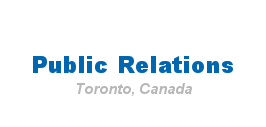Snagging Coverage
- A behind-the-scene look at what a PR professional does
Written by Ken Chiu of Icebreaker Public Relations
Article printed in Enterprise Magazine
I often meet people at events who seem fascinated when I say I’m in public relations. Yet, what exactly is it we do, no one seems to really know. Some think we go to parties every day. A few lucky PR folks do – just not me. People see the results, the media coverage our clients obtain in newspapers, magazines, TV and radio, but what do PR people actually do? Here’s a behind-the-scene look at a recent project for a client.
The Ground Work
The client, an Internet service provider (ISP), had completed an online database project for a government agency. This government agency often sends out a survey through the mail to gather information. The client worked with the government agency to move the survey online so that the question can be completed on the web instead of on paper. The online approach would eliminate postage, printing, data entry and reduce the preparation time in creating each survey.
Several potential story angles exist. There’s the new client announcement, a client case study… If the technology was new, that too would be an angle. The client and I decide that the case study offered the most potential to reveal what this client does. Trade magazines also love case studies.
We need to frame the angle in the best light. Just saying “this was a project to help the government” does not make it stand out or explain what the big deal is. Journalists want something unusual. The client and I determine that we would use a “paperless” theme since the government department was moving away from paper surveys. Going “paperless” would imply less cost, easier to make updates, easier to process information, etc. Therefore, the angle to be pitched is the client helped the government department go paperless with its survey.
Contacting the Media
Appropriate print journalists and publications need to be identified. I compile a media list of targeted publications and journalists relevant to this story. This list consists mainly of technology and government trade journalists. Why not approach as many magazines and newspapers as possible? Time and costs are limited. The target publications offered the best prospect of picking up the story.
I begin pitching journalists on our media list with the case study idea. The pitches are emailed because technology writers prefer email. I briefly tell them about the project, provide some facts, and mention that interview sources are available. After that, it becomes a waiting game for responses. This is where a client needs patience, basically forget about it and move on to the next project. “A watched pot never boils”. Sometimes pitches grab a lot of attention, sometimes they don’t.
There are plenty of variables as to which stories an editor might select. Some factors include deadlines, whether such a story ran recently, if the story is seasonal or best kept for an upcoming issue, if the topic is trendy, etc. The case study is not an urgent, time-dependent announcement like a merger or new product announcement that requires immediate attention.
A journalist calls the next day. The journalist would like to set up an interview with the client. I brief the client on what the journalist may ask to help the client prep for the interview. Once the interview is completed, I follow-up with the client to see how it went. I follow-up with the journalist, thanking him for the opportunity. Soon after, an editor of a government technology magazine calls and wants to assign the story to a freelance writer. I help set up the interview arrangements just as before. We get a few more responses from other publications over the next week. One writer requests a photo to accompany the article. We send him a digital image of the client in an action shot of him in the boardroom with his team.
The media coverage is tracked afterwards. This case study generated several lengthy articles worth over $25,000 and reached over 100,000 readers in circulation. The articles described how the Internet service provider helped the government agency with its online project. Readers now know a little more about services from this ISP and how they work.
Conclusion
Many tools exist that public relations experts use to help leverage a client. The above example was merely one. What worked for one business may not work for another. That’s why a PR professional helps. We help maximize your chances of finding opportunities and help frame the story in the best light. PR is always unpredictable. But when it is done well, it is very exciting to see the results trickle in.
| 
